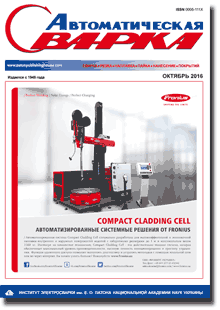| 2016 №10 (04) |
DOI of Article 10.15407/as2016.10.05 |
2016 №10 (06) |

Avtomaticheskaya Svarka (Automatic Welding), #10, 2016, pp. 28-34
Comparison of procedures for evaluation of effect of welding thermal cycle on impact toughness of HAZ metal of welded joints from low-alloy steels
V.D. Poznyakov, L.I. Markashova, S.L. Zhdanov, E.N. Berdnikova, A.V. Zavdoveev and A.A. Maksimenko
E.O. Paton Electric Welding Institute, NASU 11 Kazimir Malevich Str., 03680, Kiev, Ukraine. E-mail: office@paton.kiev.ua
Abstract
One of the most important indices of mechanical properties, which together with other factors determine the quality and working capacity of the welded joints, is impact toughness. Impact toughness is characterized by material capability to absorb mechanical energy in process of deformation and fracture under impact load effect. This paper carries a comparative evaluation of effect of welding on impact toughness of HAZ metal of specimens, produced from bead-on-plate tests, and reference ones, treated on welding thermal cycle, from steel 10G2FB. It is determined that effect of the welding thermal cycles on impact toughness indices of HAZ metal of welded joints from steel 10G2FB is ambiguous. Rapid decrease of KCU and KCV values is observed at w6/5 < 6 °C/s cooling rates. Increase of cooling rate provides for rise of HAZ metal impact toughness and in some cases it reaches KCU and KCV values of base metal. Therefore, it is a good correlation of the values of impact toughness between the specimens, treated on welding thermal cycle, and specimens, produced from welded joints. It is insignificant difference in nature of their fracture. 7 Ref., 2 Tables, 6 Figures.
Keywords: low-alloy steel, impact toughness, welding thermal cycle, bead-on-plate test, heat-affected zone, structure, fracture surface
Received: 26.10.16
Published: 23.10.16
References
- (1991) Metals science and heat treatment of steel: Refer. Book. Ed. by M.L.Bernshtejn, A.G. Rakhshtadt. Vol.1: Methods of testing and research. Moscow: Metallurgiya.
- Emelyushin, A.N., Sychkov, A.B., Sheksheev, M.A. (2012) Examination of weldability of high-strength pipe steel of K56 strength grade. Vestnik Magnitogorskogo Gos. Tekhn. Un-ta im. G.I. Nosova, Issue 3, 26–30.
- Gulakov, S.V., Nosovsky, B.I., Novokhatskaya, A.S. et al. (2008) Method and equipment for simulation of welding(surfacing) thermal cycle. Visnyk Pryazov. Derzh. Tekhn. Un-tu, Issue 18, Pt 1, 179–183.
- Stolyarov, V.I., Efimenko, L.A., Elagina, O.Yu. et al. (2008) Weldability of high-strength pipe steels for large diameter gas pipes. Chyorn. Metallurgii i Materialoveneniya, 3, 39–47.
- Nazarov, A.V., Yakushev, E.V., Shabalov, I.P. et al. (2014) Comparison of weldability of high-strength pipe steels microalloyed with niobium, niobium and vanadium. Metallurgist, 57(Issue 9), 911–917. https://doi.org/10.1007/s11015-014-9821-6
- Efimenko, L.A., Elagina, O.Yu., Vyshemirsky, E.M. et al. (2010) Evaluation of influence of technological and service parameters on life and safety of assembly welded joints of stop valves. Khimicheskoe i Neftegazovoe Mashinostroenie, 2, 42–45.
- Poznyakov, V.D., Markashova, L.I., Maksimenko, A.A. et al. (2014) Effect of cyclic load on microstructure and cold resistance of 10G2FB steel HAZ metal. The Paton Welding J., 5, 2–9. https://doi.org/10.15407/tpwj2014.05.01
